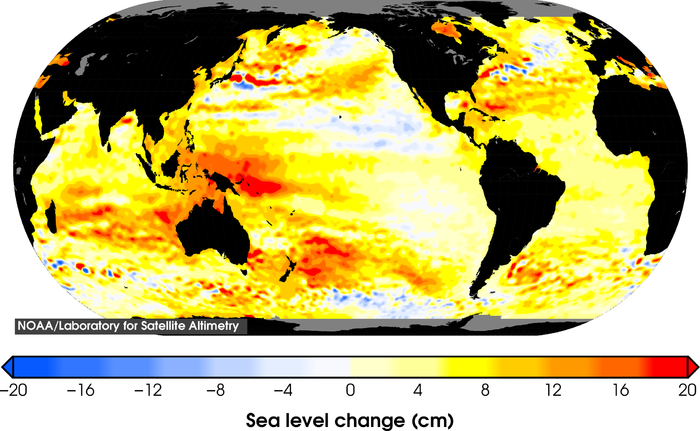Rising sea level
Rising sea levels are being caused by the increased emissions of greenhouse gases into the atmosphere, which act to trap radiant energy from the Sun and, in turn, warm the oceans. Rising sea levels are one of the main worries of global warming, and are already measurable; the increase in ocean temperatures has caused an increase in sea level by about 20 centimeters in the past century.[1]
There are two reasons for warming oceans to cause an increase in sea level:[1][2]
- Molecules gain more kinetic energy at higher temperatures and cause the water to take up more space. This is known as thermal expansion. (~1 mm/year)
- This extra heat causes sea ice sheets to melt, which allows their water to flow freely into the oceans. This matter is particularly worrying because it creates a positive feedback cycle which amplifies the effect. Continental ice on Greenland and west Antartica is also warming at an accelerated pace, contributing to the rising levels. (~2 mm/year)
Figure 1 below shows the changing levels of the oceans since 1993.

Consequences
When sea levels rise rapidly, they can have devastating consequences on coastal regions. As seawater reaches inland, it can cause destructive erosion and flooding, contamination of aquifers, and loss of habitat for fish, plants, animals and humans.[4]
When extreme weather events occur, higher sea levels mean more powerful storms near major cities. Moreover, hundreds of millions of people live in coastal regions that are becoming increasingly vulnerable to flooding.[4] Potential damage as a result of rising sea levels has been studied in detail, and two categories have emerged in terms of which cities will be affected the most: highest overall cost of damage and overall cost as a percentage of GDP (in other words, cities that are poor or have many people, and would be devastated the most by an extreme event).[5]
The 10 cities that are estimated to suffer the highest cost of damage in the event of such catastrophes are:[5]
- Guangzhou (China)
- Miami (USA)
- New York (USA)
- New Orleans (USA)
- Mumbai (India)
- Nagoya (Japan)
- Tampa (USA)
- Boston (USA)
- Shenzhen (China)
- Osaka (Japan)
The 10 cities that are most vulnerable, leading to the most devastation include:[5]
- Guangzhou (China)
- New Orleans (USA)
- Guayaquil (Ecuador)
- Ho Chi Minh City (Vietnam)
- Abidjan (Ivory Coast)
- Zhanjiang (China)
- Mumbai (India)
- Khulna (Bangladesh)
- Palembang (Indonesia)
- Shenzhen (China)
The video below by the World Bank discusses this sea level change and its consequences in detail.
References
- ↑ 1.0 1.1 M. Melieres and C. Marechal, "The impact of warming on the ocean," in Climate Change: Past, Present and Future 1st ed., U.K.: Wiley, 2015, ch.27, pp. 273-283
- ↑ NASA. (Accessed November 7 2015). Sea Level Rise [Online], Available: http://climate.nasa.gov/climate_resources/125/
- ↑ NOAA/NESDIS. (Accessed December 28, 2015). Sea Level Rise [Online], Available: http://www.star.nesdis.noaa.gov/sod/lsa/SeaLevelRise/
- ↑ 4.0 4.1 National Geographic. (Accessed January 7, 2016). Sea Level Rise [Online], Available: http://ocean.nationalgeographic.com/ocean/critical-issues-sea-level-rise/
- ↑ 5.0 5.1 5.2 World Bank. (Accessed December 31, 2015). Which Coastal Cities Are at Highest Risk of Damaging Floods? [Online], Available: http://www.worldbank.org/en/news/feature/2013/08/19/coastal-cities-at-highest-risk-floods

